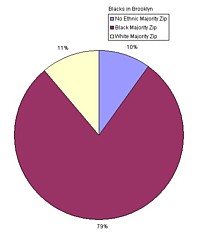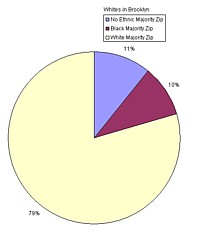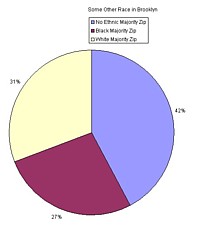Thursday, June 09, 2005
Racial Segregation in Brooklyn
Several days ago I was messing around at the invaluable City-Data site, a veritable fountain of knowledge for statistical geeks like myself, when I decided to have a look at what info they had on my old Brooklyn zip code, 11222. Not surprisingly, it showed that it is 80% white, because Greenpoint (for that is what it is) is the central home of the city's Polish community. I then started to have a look at other Brooklyn zip codes, punching in different numbers, seemingly at random, and what quickly became apparent was that, in Brooklyn as in the rest of the country, blacks and whites rarely live in areas where they have much statistical parity. So, I decided to do the whole shebang, to comb through all of Brooklyn's residential zip codes for the ethnicity data and see what I came up with on black-white residential segregation.
Why Brooklyn? And why blacks and whites? Well, according to the census data there is a pretty rough numerical parity between the two groups, the two main historical racial groups in American society, and black segregation in housing, education, and many other things from white America has long been pervasive, conscious, and deep. I also chose Brooklyn because it has the lowest percentage of Asians and Hispanics of the city's boroughs, with the exception of white majority Staten Island, and I wanted to look at continuing residential segregation between whites and blacks. Of course, in Brooklyn terms, 'whites' and 'blacks' are not simple categories (not that anywhere else in America these are simple categories, merely that in Brooklyn the mix is more complex), with Brooklyn being home to large, and recent, immigrant communities from the former Soviet Union, Poland, the Caribbean (particularly Haiti, Jamaica, and Trinidad), and Africa.
A quick note: the City-Data site from which I got my information on each zip code took its information from the 2000 census. It being five years later, the information for many areas is almost certainly already out of date, yet still, on a broad scale, I believe that it is useful. City-Data only breaks out the data by the five main categories for racial self-identification, and does not provide stand-alone data for Hispanics (as Hispanics can be of any race). This means that those Hispanics who self-identify as white or black on the form have been placed in the white and black categories in this data. If anyone can point me towards a zip code compendium that does break out Hispanic data by itself, then I would be grateful. Although I'm not all too sure about our tendency to set up 'Hispanic/Latino' as a quasi-racial category in and of itself, because, as the writer Richard Rodriguez has said, "Hispanics do not constitute a racial group. Members of every race in the world can claim to be Hispanics. As Hispanics -- the blond Cuban, the black Dominican, the mestizo Mexican -- we assert a cultural tie."
One useful thing to remember when looking at the data below is that it comes from Census Department definitions, which are often at variance with others' definitions of who fits into what group. The most pertinent example of this is the white category, which, in the official definition, includes Middle Easterners and North Africans who a majority of people probably see as non-White (their inclusion probably goes back to the 'Caucasoid' racial theories of the 19th century, and the fact that for some time the majority of Middle Eastern immigrants were Levantine Christians, who themselves tend to be often physically indistinguishable from Southern Europeans). Again, unless I can find some other source that breaks these out, I've got to go with what I have. It is also useful to remember that, for the most part, in this census data the designation 'some other race' usually refers to Hispanics who haven't put down 'Hispanic and Black/White' on the form. I haven't included Native Americans or Native Hawaiians/Pacific Islanders on any of these charts or pie graphs because, between the two of them, they only account for around 0.4% of the borough's population, and for graphical clarity it is easier to leave them out. If you are a member of either group, I apologize for leaving you out.
So, what do I have? What did I find? Unsurprisingly, racial segregation between blacks and whites in Brooklyn (as elsewhere in the country) continues to be a genuine reality. Of Brooklyn's thirty-seven residential zip codes, 17 have a white majority, 13 have a black majority, and seven have no majority at all (in the 2000 census, no group besides blacks or whites formed a majority in any zip code in Brooklyn).


Click all images to be taken to a larger version
As you can see from the pie graphs above, the vast majority of both blacks and whites in Brooklyn live in zip codes where they are in the majority. Indeed, 67% of blacks and 57% of whites live in zip codes where their group makes up at least 65% of the population. Only 9% of whites and 10% of blacks live in zip codes where the other group is in the numerical majority.
Above you will find line graphs that illustrate the breakdown of the different zip codes, first showing black majority zip codes, then white majority zip codes, and finally those few zip codes without an outright racial/ethnic majority. As you can see, the higher each group's concentration goes, the more that numbers of all other groups collapse, with the exception of Asians in predominantly white areas. This was the factor that I was most surprised to find, and it's something that I am quite curious about. While 69% of Brooklyn's Asian population lives in majority white zip codes (including 57% in zip codes that are over 65% white), only 8% live in majority black zip codes, lower even than the proportion of whites who live in such areas. Of course, 'Asian' in the Brooklyn context can mean many things, from the Chinese community in Sunset Park to the Pakistani community around Coney Island Avenue in Midwood.
I have to be honest here and say that I don't really have any explanation as to the difference, why Asians live far more among whites than they do among blacks. Perhaps part of it is racial prejudice against blacks among some Asian immigrants? Perhaps there is more of a turnover of housing in traditionally white neighborhoods than in traditionally black neighborhoods? Perhaps it is a matter of getting access to the better schools in Brooklyn (which are not in the heart of the Central Brooklyn ghetto)? Or maybe it is just a matter of chain migration, where certain early settlers chose specific neighborhood and then passed the word back to family and friends? Or maybe a sizeable proportion of Brooklyn's Asian population is made up of American-born middle-class Asian-Americans, who have chosen to settle in the sort of middle-class areas in Brooklyn that are usually (although not always) mostly white? I don't know, but if you have any ideas about this, leave a comment in the comments box. I've tried to do some research on the matter on Google, but haven't come up with much of interest, mostly just hectoring identity politics. Is this a local quirk, or is it true elsewhere in the United States that Asians will rarely live in largely black communities?
Above you can see the distribution of Asian and 'Some Other Race' (ie Hispanics who haven't put down black or white as a racial category) in Brooklyn. As you can see, those of 'Some Other Race' (ok, Hispanics) are much more evenly distributed than Asians in terms of their neighbors in Brooklyn. It is also useful to remember that in all likelihood several of those zip codes with no racial/ethnic majority that I found are probably mostly Hispanic, and they don't show up as such in the data because the City-Data site doesn't include Hispanic numbers as part of their number-crunching, so quite a few Hispanics will be in the white and black categories. There is, of course, nothing wrong with this; I'm not going to argue with how people choose to define themselves. If you are black and Dominican, you're still black. Or, if you are white and Argentinean, you are still white. Whatever, I digress.
Finally, here's the main thing. Colored zip code maps for blacks and whites in Brooklyn. It took me hours to do these. If you want a fresh, untouched version, you can find one here.
As you can see, the difference between where blacks and whites live is quite dramatic, with minuscule black populations throughout virtually all of southern Brooklyn, and hardly any whites in central Brooklyn, which has the largest number, and highest concentration, of African-Americans in the whole city. So, why are blacks and whites still so segregated in Brooklyn? Well, it's a complex area, and it's certainly not a new phenomenon. In some areas, it is merely a matter of recent immigrants clustering together, as among the Russians of Brighton Beach or the West Indians in Flatbush. Partly, also, a lot of the poorest African-Americans in neighborhoods like Brownsville and Bedford-Stuyvesant simply can't afford to move to whiter, more middle-class areas like Bay Ridge or Bensonhurst, and those who can afford to move are more likely to head for black middle-class areas or the suburbs than to neighboring, long-established 'white ethnic' areas. I would also argue thatwhites are, on average, more hostile to the idea of living among large numbers of blacks than they are to living alongside large numbers of Asians or Hispanics, which seems to be borne out by the statistics of who lives where. Education also plays a role in perpetuating black-white residential segregation. The worst schools in the borough are mostly located in these ghetto neighborhoods of central Brooklyn, trapping further generations in low-income lifestyles, with little chance of change. A comprehensive re-ordering of the city educational system has been wrangled over for years, but the failure of many schools plays a serious role in the perpetuation of racial segregation in the borough.
This is not to say that all African-Americans in the borough are poor; they are not. There are enclaves of middle-class blacks throughout Brooklyn, in places like Clinton Hill and Fort Greene. There is also often a reluctance among whites to move into black areas, over issues of not wanting to be a minority in the neighborhood and worries about crime (crime rates are still very high by city standards in the poorest, most black, neighborhoods, of Brooklyn, although they are down dramatically from the early 90's), and education (which is why few of these white newcomers tend to be families with children) although that is changing with the filtering in of some artists and young professionals into areas like Bed-Stuy.
Of course, Brooklyn is always changing, and the maps of today will undoubtedly fail to describe the reality of ten years hence. For now, though, this is the situation.
Update, July 6th, 2005: For anyone arriving here by Google, there is a sequel to this post with loads more stuff here. Topics covered in the sequel include median household income, the distribution of Asians in Brooklyn, crime rates, and the public schools.









